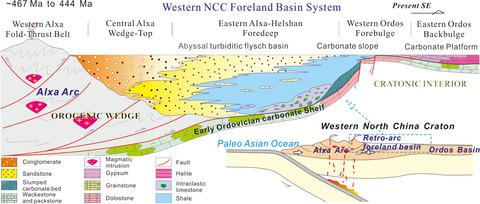当前位置:
X-MOL 学术
›
Basin Res.
›
论文详情
Our official English website, www.x-mol.net, welcomes your feedback! (Note: you will need to create a separate account there.)
Ordovician tectonic shift in the western North China Craton constrained by stratigraphic and geochronological analyses
Basin Research ( IF 3.2 ) Pub Date : 2020-02-11 , DOI: 10.1111/bre.12435 Jiaopeng Sun 1 , Yunpeng Dong 1, 2
Basin Research ( IF 3.2 ) Pub Date : 2020-02-11 , DOI: 10.1111/bre.12435 Jiaopeng Sun 1 , Yunpeng Dong 1, 2
Affiliation

|
[Abstract The western North China Craton (W‐NCC) comprises the Alxa Terrane in the west and the Ordos Block in the east; they are separated by the Helanshan Tectonic Belt (HTB). There is an extensive debate regarding the significant Ordovician tectonic setting of the W‐NCC. Most paleogeographic reconstructions emphasized the formation and rapid subsidence of an aulacogen along the HTB during the Middle–Late Ordovician, whereas paleomagnetic and geochronologic results suggested that the Alxa Terrane and the Ordos Block were independent blocks separated by the HTB. In this study, stratigraphic and geochronologic methods were used to constrain the Ordovician tectonic processes of the W‐NCC. Stratigraphic correlations show that the Early Ordovician strata comprise ~500‐m‐thick tidal flat and lagoon carbonate successions with a progressive eastward onlap, featuring a west‐deepening shallow‐water carbonate shelf. In contrast, the Late Ordovician strata are composed of ~3,000‐m‐thick abyssal turbidites in the west and ~400‐m‐thick shallow‐water carbonates in the east, defining an eastward‐tapering basin architecture. Early Ordovician detrital zircons with ages of ~2,800–1,700 Ma were derived from the Ordos Block; the Late Ordovician turbidites were sourced from the western Alxa Terrane, based on zircon ages clustered at ~1,000–900 Ma. The petrographic modal composition and zircon age distribution imply a provenance shift from a stable craton to a recycled orogen in the Middle Ordovician. These shifts define a tectonic conversion from a passive continental margin to a foreland basin at ~467 Ma, resulting in the eastward progradation of the turbidite wedge around the HTB, the eastward backstepping of the carbonate platform in the east and the eastward expansion of orogenic thrusting in the western Alxa Terrane. This tectono‐sedimentary shift coincided with the advancing subduction of the southern Paleo‐Asian Ocean beneath the Alxa Terrane, generating the western Alxa continental arc and the paired retro‐arc foredeep in the east under a compressional tectonic regime., Reconstruction model of the Ordovician tectono‐sedimentology evolution of the Northwestern Ordos Terrane. ]
中文翻译:

受地层和年代学分析约束的华北克拉通西部奥陶纪构造位移
[摘要 华北克拉通西部(W-NCC)包括西部的阿拉善地块和东部的鄂尔多斯地块;它们被贺兰山构造带(HTB)隔开。关于 W-NCC 重要的奥陶纪构造背景存在广泛的争论。大多数古地理重建强调了中-晚奥陶世沿HTB形成和快速下沉,而古地磁和地质年代学结果表明阿拉善地块和鄂尔多斯地块是被HTB分开的独立块体。在这项研究中,地层学和地质年代学方法被用来约束 W-NCC 的奥陶纪构造过程。地层对比表明早奥陶世地层包括~500 米厚的潮滩和泻湖碳酸盐岩层序,逐渐向东上搭,具有向西加深的浅水碳酸盐岩陆架。相比之下,晚奥陶世地层由西部约 3,000 米厚的深海浊积岩和东部约 400 米厚的浅水碳酸盐岩组成,形成了向东逐渐变细的盆地结构。年龄为~2,800-1,700 Ma的早奥陶世碎屑锆石来自鄂尔多斯地块;根据聚集在~1,000-900 Ma的锆石年龄,晚奥陶世浊积岩来自阿拉善地块西部。岩相模态组成和锆石年龄分布意味着中奥陶世从稳定克拉通到再生造山带的物源转变。这些位移定义了在~467 Ma从被动大陆边缘到前陆盆地的构造转换,导致HTB周围的浊积楔向东进积,东部碳酸盐台地向东后退和造山带向东扩张在阿拉善地块西部。这种构造-沉积转变与阿拉善地块下方古亚洲洋南部的推进俯冲相吻合,在挤压构造体制下产生了西部阿拉善大陆弧和东部成对的弧后前深部。, 奥陶纪重建模型鄂尔多斯地体西北部构造沉积演化. ] 东部碳酸盐岩台地东后退和阿拉善地块西部造山逆冲东扩。这种构造-沉积转变与阿拉善地块下方古亚洲洋南部的推进俯冲相吻合,在挤压构造体制下产生了西部阿拉善大陆弧和东部成对的弧后前深部。, 奥陶纪重建模型鄂尔多斯地体西北部构造沉积演化. ] 东部碳酸盐岩台地东后退和阿拉善地块西部造山逆冲东扩。这种构造-沉积转变与阿拉善地块下方古亚洲洋南部的推进俯冲相吻合,在挤压构造体制下产生了西部阿拉善大陆弧和东部成对的弧后前深部。, 奥陶纪重建模型鄂尔多斯地体西北部构造沉积演化. ] 在挤压构造体制下产生西部阿拉善大陆弧和成对的东部弧后前渊。鄂尔多斯地块西北部奥陶纪构造沉积演化重建模型。] 在挤压构造体制下产生西部阿拉善大陆弧和成对的东部弧后前渊。鄂尔多斯地块西北部奥陶纪构造沉积演化重建模型。]
更新日期:2020-02-11
中文翻译:

受地层和年代学分析约束的华北克拉通西部奥陶纪构造位移
[摘要 华北克拉通西部(W-NCC)包括西部的阿拉善地块和东部的鄂尔多斯地块;它们被贺兰山构造带(HTB)隔开。关于 W-NCC 重要的奥陶纪构造背景存在广泛的争论。大多数古地理重建强调了中-晚奥陶世沿HTB形成和快速下沉,而古地磁和地质年代学结果表明阿拉善地块和鄂尔多斯地块是被HTB分开的独立块体。在这项研究中,地层学和地质年代学方法被用来约束 W-NCC 的奥陶纪构造过程。地层对比表明早奥陶世地层包括~500 米厚的潮滩和泻湖碳酸盐岩层序,逐渐向东上搭,具有向西加深的浅水碳酸盐岩陆架。相比之下,晚奥陶世地层由西部约 3,000 米厚的深海浊积岩和东部约 400 米厚的浅水碳酸盐岩组成,形成了向东逐渐变细的盆地结构。年龄为~2,800-1,700 Ma的早奥陶世碎屑锆石来自鄂尔多斯地块;根据聚集在~1,000-900 Ma的锆石年龄,晚奥陶世浊积岩来自阿拉善地块西部。岩相模态组成和锆石年龄分布意味着中奥陶世从稳定克拉通到再生造山带的物源转变。这些位移定义了在~467 Ma从被动大陆边缘到前陆盆地的构造转换,导致HTB周围的浊积楔向东进积,东部碳酸盐台地向东后退和造山带向东扩张在阿拉善地块西部。这种构造-沉积转变与阿拉善地块下方古亚洲洋南部的推进俯冲相吻合,在挤压构造体制下产生了西部阿拉善大陆弧和东部成对的弧后前深部。, 奥陶纪重建模型鄂尔多斯地体西北部构造沉积演化. ] 东部碳酸盐岩台地东后退和阿拉善地块西部造山逆冲东扩。这种构造-沉积转变与阿拉善地块下方古亚洲洋南部的推进俯冲相吻合,在挤压构造体制下产生了西部阿拉善大陆弧和东部成对的弧后前深部。, 奥陶纪重建模型鄂尔多斯地体西北部构造沉积演化. ] 东部碳酸盐岩台地东后退和阿拉善地块西部造山逆冲东扩。这种构造-沉积转变与阿拉善地块下方古亚洲洋南部的推进俯冲相吻合,在挤压构造体制下产生了西部阿拉善大陆弧和东部成对的弧后前深部。, 奥陶纪重建模型鄂尔多斯地体西北部构造沉积演化. ] 在挤压构造体制下产生西部阿拉善大陆弧和成对的东部弧后前渊。鄂尔多斯地块西北部奥陶纪构造沉积演化重建模型。] 在挤压构造体制下产生西部阿拉善大陆弧和成对的东部弧后前渊。鄂尔多斯地块西北部奥陶纪构造沉积演化重建模型。]



























 京公网安备 11010802027423号
京公网安备 11010802027423号